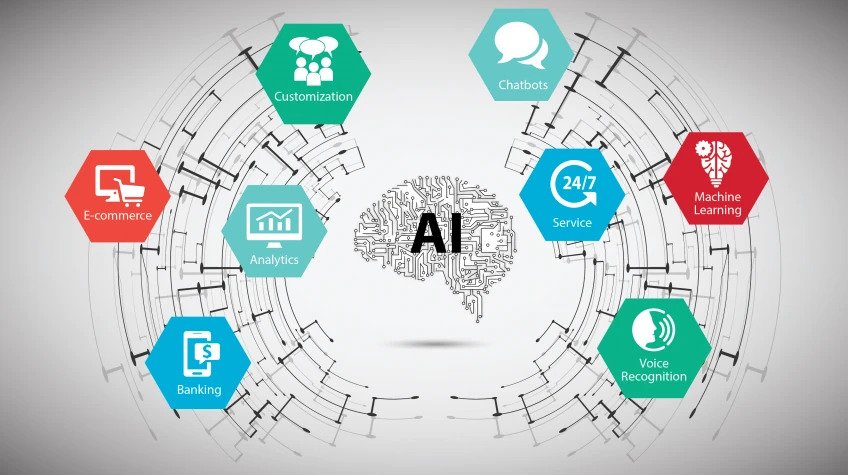The retail industry is undergoing a major transformation, driven by advancements in technology. One of the most exciting developments is the use of AI-powered predictive tools. These tools are changing how retailers understand their customers, manage inventory, and optimize their operations. This article explores the latest trends in retail, focusing on how AI-powered predictive tools are making a significant impact. Let’s dive into how these innovations are shaping the future of retail.
Understanding AI-Powered Predictive Tools
Strategic Integration of AI in Retail
For startup founders looking to harness the power of AI-powered predictive tools, it’s crucial to understand the strategic integration of these technologies into your business operations. AI isn’t just a plug-and-play solution; it requires a thoughtful approach to ensure it aligns with your business goals and maximizes ROI.
Firstly, it’s essential to identify the specific areas where AI can make the most significant impact. Whether it’s inventory management, customer engagement, or supply chain optimization, understanding your pain points and business priorities will guide the effective deployment of AI tools. For instance, if your startup struggles with frequent stockouts or excess inventory, focusing on AI-driven demand forecasting can yield immediate benefits.

With a decade of experience in tech and data analytics, I’ve seen how AI-powered predictive tools can transform startups by aligning closely with business objectives, especially in dynamic sectors like retail.
Question and Answer:
Q1: How should new retail businesses strategically plan and align AI tools with their business goals?
A: For startups, the strategic use of AI begins with clarity on specific business objectives—whether enhancing customer insights, refining inventory management, or optimizing pricing.
AI tools should address a primary need directly tied to growth goals. Retail startups can apply a similar strategy by using AI to identify and predict customer buying patterns, allowing them to make targeted inventory decisions based on forecasted demand.
Q2: What are best practices for integrating AI tools in retail startups?
A: A phased approach is critical; start with a limited AI application, focusing on one clear goal before scaling.
For instance, a smaller retail brand might use AI for customer segmentation to better understand purchasing patterns before expanding to predictive inventory management.
Additionally, it’s essential to regularly evaluate the performance of AI tools, ensuring they adapt to changing consumer behaviors and provide actionable insights rather than simply data.
Retail startups benefit from AI tools that allow them to test hypotheses and refine strategies iteratively, rather than implementing rigid solutions.
Q3: Real-world examples of effective AI implementation in small or mid-sized retail operations?
A: Take ThirdLove, a mid-sized lingerie brand that uses AI to analyze fit and style preferences through its Fit Finder tool, allowing it to personalize recommendations while optimizing inventory.
For a smaller operation, consider an independent coffee roastery that uses AI to forecast demand spikes based on seasonal variations and local events, adjusting inventory orders accordingly to minimize waste and meet customer demand.
These examples show how targeted, thoughtful integration of AI can drive customer loyalty while reducing operational inefficiencies.
Building a Data-Driven Culture
Implementing AI-powered predictive tools requires a robust data infrastructure. As a startup founder, fostering a data-driven culture within your organization is paramount. This means investing in the right technologies for data collection, storage, and processing. It also involves training your team to value data and make decisions based on insights rather than intuition.
Start by ensuring that all relevant data points are being captured accurately. This includes sales data, customer interactions, inventory levels, and external factors like market trends. Use data visualization tools to make the insights accessible and understandable to your team. Regularly review the data to identify trends, anomalies, and opportunities for improvement.
Selecting the Right AI Tools
Choosing the right AI tools can be overwhelming given the myriad of options available. For startup founders, it’s essential to select tools that are scalable, user-friendly, and aligned with your specific business needs. Consider tools that offer customization options and can integrate seamlessly with your existing systems.
Partner with vendors who provide robust support and training. This ensures that your team can effectively use the tools and troubleshoot any issues that arise. Start with a pilot project to test the effectiveness of the AI tool in a controlled environment before rolling it out across your entire operation.
Enhancing Customer Insights

AI-powered predictive tools can provide deep insights into customer behavior, preferences, and trends. As a startup, leveraging these insights can give you a competitive edge. Use AI to segment your customers more precisely, understanding their unique needs and preferences. This enables you to tailor your marketing efforts and product offerings to meet their specific demands.
For example, if AI identifies that a segment of your customers prefers eco-friendly products, you can adjust your inventory and marketing strategies to cater to this preference. Personalized marketing campaigns based on predictive insights can significantly enhance customer engagement and loyalty.
Improving Operational Efficiency
Operational efficiency is critical for the sustainability and growth of any startup. AI-powered predictive tools can streamline various aspects of your operations, from inventory management to supply chain logistics. By predicting demand accurately, you can optimize your stock levels, reducing the costs associated with overstocking and stockouts.
Implement AI to automate routine tasks, freeing up your team to focus on strategic initiatives. For instance, automated inventory replenishment based on predictive analytics can ensure that you always have the right amount of stock on hand without manual intervention. This not only saves time but also minimizes human errors.
Continuous Improvement and Adaptation
AI-powered predictive tools are not a one-time solution but require continuous monitoring and adaptation. As a startup founder, it’s crucial to regularly review the performance of your AI tools and make necessary adjustments. This involves analyzing the accuracy of predictions, the efficiency of automated processes, and the overall impact on your business operations.
Solicit feedback from your team to identify any challenges they face with the AI tools and address these issues promptly. Stay updated with the latest advancements in AI technology and be open to integrating new features or tools that can further enhance your operations.
Aligning AI with Business Goals
For AI-powered predictive tools to be truly effective, they must be aligned with your broader business goals. Define clear objectives for your AI initiatives, such as increasing sales, improving customer satisfaction, or reducing operational costs. Establish key performance indicators (KPIs) to measure the success of your AI projects and ensure they contribute to your overall strategy.
Communicate these goals and KPIs to your team, so everyone understands the purpose of the AI tools and how their work contributes to achieving these objectives. Regularly review the progress towards these goals and adjust your strategies as needed to stay on track.
Trends in Customer Behavior
Personalization and Customer Experience
One of the biggest trends in retail is personalization. Customers today expect personalized experiences tailored to their preferences. AI-powered predictive tools help retailers understand individual customer preferences and behavior. By analyzing data from past purchases, browsing history, and social media activity, these tools can create personalized recommendations for each customer.
For example, online retailers can use predictive tools to recommend products based on a customer’s past purchases and browsing history. This not only enhances the shopping experience but also increases the likelihood of a purchase. Personalization is key to building customer loyalty and increasing sales.

I will demonstrate how AI-powered predictive tools are reshaping retail by offering personalized experiences that customers love.
Another great example of the effective use of AI is AI-driven product recommendations which are one of the most effective tools that use data on previous purchases and the customer’s browsing history to suggest products and items that the customer might like.
For instance, if the person often purchases products from the category of home décor the AI will suggest similar products to buy which makes the process of searching for the location, needed and item preference simpler to and send more messages satisfying.
In at targeted the marketing, right AI time. employs This the is customer’s because behavior, it makes the customers feel that they are being respected and understood of their needs thus building a certain level of loyalty for the particular brand.
This is where personalization helps in enhancing loyalty as it involves understanding and meeting customer’s some needs of even the before technologies they that realize are it.
Used Machines to learning determine and customer natural preferences language and processing enhance (NLP) the are recommendations in real time.
Predicting Customer Demand
Another critical application of AI in retail is predicting customer demand. Accurate demand forecasting is essential for managing inventory and ensuring that products are available when customers want them. AI-powered predictive tools analyze historical sales data, market trends, and even weather patterns to forecast demand.
For example, a clothing retailer can use AI to predict which styles and sizes will be in demand during different seasons. This helps them avoid overstocking unpopular items and running out of popular ones. By accurately predicting demand, retailers can reduce waste, lower costs, and improve customer satisfaction.
Enhancing Customer Engagement
AI-powered predictive tools also play a significant role in enhancing customer engagement. By analyzing customer data, these tools can identify the best times and channels to engage with customers. For instance, AI can determine the optimal time to send promotional emails or push notifications, increasing the chances of customer interaction.
Additionally, predictive tools can help retailers understand customer sentiment by analyzing social media interactions and reviews. This allows them to address customer concerns proactively and improve their overall experience. Engaging customers at the right time and through the right channels is crucial for building strong relationships and driving sales.
Optimizing Inventory Management

Strategic Inventory Planning
For startup founders, strategic inventory planning is crucial to ensure that resources are allocated efficiently. AI-powered predictive tools can revolutionize your inventory management by providing accurate forecasts and insights. Begin by setting clear inventory goals that align with your overall business objectives, such as minimizing holding costs, reducing stockouts, and improving turnover rates.
Use AI to analyze historical sales data, seasonal trends, and market demand. This analysis helps in creating a more accurate inventory plan, ensuring you have the right products in the right quantities at the right time. Implementing a just-in-time inventory system can be particularly beneficial, reducing the amount of capital tied up in stock and minimizing the risk of obsolescence.

With over a decade of experience leveraging predictive analytics, I’ve seen how AI can play a transformative role in demand forecasting and inventory optimization, especially in industries with fast-changing consumer trends.
Question and Answer:
Q1: How is AI transforming demand forecasting and inventory optimization in retail?
A: AI brings an unprecedented level of precision to demand forecasting by analyzing vast data sets, including past sales trends, seasonal patterns, and external factors like weather or local events.
AI’s ability to quickly parse and interpret these variables enables retailers to predict demand with much higher accuracy, reducing the risks of stockouts or overstocking.
Q2: Can you provide specific use cases that show how AI helps retailers avoid stockouts and excess inventory?
A: One powerful use case is seen in seasonal markets where AI models help anticipate fluctuations in demand and adjust inventory accordingly.
For instance, a sportswear retailer can use AI to predict spikes in demand for winter gear as early as late summer, based on patterns from prior years combined with emerging trends.
By leveraging AI, the retailer can proactively stock up on high-demand items while scaling back on items likely to see slower movement, minimizing both stockouts and excess.
In another example, smaller fashion brands like Stitch Fix employ AI-driven demand forecasting to reduce overproduction, which is especially beneficial in fast-changing fashion markets.
The AI continuously analyzes customer preferences and order data to adjust inventory levels in near real-time, creating a leaner supply chain and reducing waste.
Q3: What are the benefits of using AI in fast-changing markets?
A: In fast-changing markets, AI’s responsiveness enables retailers to be agile, pivoting inventory levels and orders quickly in response to shifting consumer preferences.
AI-driven tools like real-time sales forecasting, coupled with inventory management software, allow brands to rapidly adjust restocking cycles, maintaining a delicate balance between supply and demand.
For instance, AI tools can assess trending products across social media, indicating a surge in interest before it manifests in-store, giving retailers the foresight to adjust their inventory.

By examining historical data alongside external factors like seasonality, promotions, and weather patterns, AI algorithms can predict demand with greater accuracy.
This allows retailers to refine their purchasing strategies and minimize the risks of stock outs or overstocking.
Additionally, AI can consider various market trends and consumer behavior to enhance inventory forecasts.
For instance, algorithms can analyze social media trends and customer reviews to spot emerging product trends or shifts in consumer preferences.
By integrating these insights into inventory forecasting, retailers can stay competitive and ensure they have the right products available to meet customer needs.

Being the head of XDS, we implement predictive models that may anticipate sales trends and optimize stock levels to let our customers keep an agile, data-driven approach toward supply chain management.
Artificial Intelligence for Demand Forecasting:Accuracy in Demand Prediction
We worked with a seasonal outdoor apparel brand who couldn’t keep up with the demand surge.
By implementing machine learning models using sales data in conjunction with external data, like weather patterns and trends of consumer behavior, we helped them improve forecast accuracy, particularly during peak seasons.
Optimization of Inventory with Real-time Data
Today, we predict inventory needs at thousands of locations. Reorder points changed dynamically with every shift in the demand of a season and/or the store-specific trend.
The result of this initiative was excess inventory reduced by 17.42%, thus helping attain a better balance in inventory levels by identification of slow-moving items and focusing on high-demand products based on real-time insights.
Case Study: Real-Time Adjustments for Seasonal Retail
We utilized our AI solution to overcome seasonal demand. Predictive models allowed us to align stock with high-demand items while reducing overstock during slower seasons.
This adjustment resulted in a 23.24% decrease in unsold seasonal inventory, freeing capital to be allocated toward in-demand products instead.

Global supply chains are notoriously unpredictable and can be quite costly.
As a result, there are inherent risks associated with participating in these supply chains.
In fact, at least 74% of companies report experiencing shipment delays, leading to extended lead times.
When utilizing predictive analytics in inventory management, it’s essential to consider potential risks and drawbacks.
However, predictive analytics can help identify potential risk factors in advance.
For instance, it can alert you to upcoming bad weather that could delay your supplies or highlight ongoing geopolitical events that might cause stock fluctuations.
Dynamic Stock Replenishment
Dynamic stock replenishment is a game-changer for inventory management. Traditional replenishment methods often rely on static reorder points, which may not adapt quickly enough to changing market conditions.
AI-powered predictive tools can provide dynamic, real-time adjustments to your replenishment strategies based on current sales data, trends, and external factors such as economic shifts or competitor actions.
For instance, if predictive analytics indicate a sudden increase in demand for a particular product due to a viral social media trend, the system can automatically trigger a reorder, ensuring you capitalize on the opportunity without manual intervention. This agility allows your startup to stay responsive and proactive, reducing the risk of missed sales opportunities and overstock situations.
Supplier Collaboration and Coordination
Effective supplier collaboration is essential for optimizing inventory management. AI-powered predictive tools can enhance this collaboration by providing accurate demand forecasts and inventory levels, which can be shared with your suppliers. This transparency helps suppliers align their production schedules with your needs, reducing lead times and ensuring timely deliveries.
Establish strong relationships with your key suppliers and use predictive analytics to negotiate better terms. For example, by demonstrating consistent and predictable order patterns through AI insights, you may secure volume discounts or more favorable payment terms. This strategic partnership not only improves your inventory management but also strengthens your supply chain resilience.
Inventory Segmentation and Prioritization
Not all inventory items are created equal. Inventory segmentation involves categorizing products based on their value, demand variability, and supply chain characteristics. AI-powered predictive tools can assist in this segmentation by analyzing sales data, profitability, and turnover rates for each product.
Focus on the most valuable and high-demand items, often referred to as A-class items in the ABC analysis, ensuring they are always in stock. For B and C-class items, optimize inventory levels to balance cost and availability. Prioritizing inventory based on predictive insights allows you to allocate resources more effectively and improve overall inventory efficiency.
Mitigating Risks with Predictive Analytics
Inventory management involves several risks, including demand fluctuations, supplier reliability, and market volatility. AI-powered predictive tools can help mitigate these risks by providing early warning signals and actionable insights.
For instance, if the predictive model indicates a potential supply chain disruption due to geopolitical events or natural disasters, you can take preemptive actions such as securing alternative suppliers or adjusting inventory levels.
Develop a risk management strategy that leverages predictive analytics to anticipate and respond to potential disruptions. This proactive approach ensures business continuity and reduces the impact of unforeseen events on your inventory and overall operations.
Enhancing Inventory Turnover
Inventory turnover is a critical metric for retail startups, reflecting how quickly products are sold and replaced over a period. High inventory turnover indicates efficient inventory management and strong sales, while low turnover can signify overstocking or poor sales performance. AI-powered predictive tools can help enhance inventory turnover by accurately forecasting demand and optimizing stock levels.
Regularly analyze turnover rates using predictive analytics to identify slow-moving items and take corrective actions, such as running promotions or bundling products to boost sales.
For fast-moving items, ensure that inventory levels are consistently replenished to avoid stockouts. By continuously monitoring and optimizing turnover rates, you can improve cash flow and reduce the costs associated with holding excess inventory.
Leveraging Technology for Continuous Improvement
The integration of AI-powered predictive tools in inventory management should not be a one-time effort but rather an ongoing process of continuous improvement. As a startup founder, it’s essential to regularly review the performance of your inventory management strategies and the effectiveness of the AI tools.
Conduct periodic audits to assess the accuracy of demand forecasts and the efficiency of your replenishment processes. Use these insights to refine your predictive models and make necessary adjustments.
Encourage a culture of innovation within your team, where data-driven decision-making and continuous learning are prioritized. By leveraging technology and maintaining a focus on continuous improvement, you can ensure that your inventory management processes remain agile, efficient, and responsive to changing market conditions.
Enhancing Supply Chain Efficiency
Predictive Maintenance
AI-powered predictive tools are not just limited to customer insights and inventory management; they also play a vital role in enhancing supply chain efficiency. Predictive maintenance is one such application where AI can forecast potential equipment failures and suggest maintenance before the actual breakdown occurs.
For example, in a retail distribution center, AI tools can analyze data from sensors on machinery to predict when a forklift might need servicing. This proactive approach minimizes downtime, ensures smooth operations, and avoids costly repairs. Keeping equipment running smoothly helps maintain a steady flow of goods through the supply chain.

AI-driven predictive maintenance helps avert equipment failures by forecasting when maintenance is needed.
While rule-based systems rely on fixed thresholds, machine learning (ML) systems utilize sophisticated modeling techniques to anticipate potential failures.
A crucial component of AI-based predictive maintenance is the detection of anomalies in rotating machinery.
Initially, data collected from various sensors installed on or within the machines undergoes preprocessing.
This processed data is then leveraged within decision-support systems, enhanced by artificial intelligence (AI) tools.

During my leadership at XDS, the best applications of AI and data analytics drive improvements in compensation, efficiency in administration, and e-commerce. Predictive analytics will create not only operational efficiency but also measurable cost savings and resilience in logistics operations.
AI Predictive Maintenance Tools for Logistics Needs
One of the projects we spearheaded at XDS involved reducing the maintenance cost by deploying AI-enabled diagnostics on conveyor belts and sorting machines across a retail distribution network.
This helped reduce unexpected downtime by close to 13.48%, enabling the client to manage peak loads with more reliability and without costly delays.
Predictive Analytics Reduce Disruptions
We integrated AI systems for our company’s supply chain that provided advanced alerts on forklifts and refrigeration units, thus enabling better planning around maintenance, which reduced unplanned downtime and directly impacted bottom-line performance.
Case Study: Predictive Maintenance in Retail Distribution Centers
The use of AI-driven predictive maintenance for forklifts, conveyors, and cooling systems enabled us to establish a data-driven maintenance schedule. The facility achieved a gain of 23.52% in operational efficiency.
Optimizing Logistics and Transportation
Efficient logistics and transportation are crucial for timely delivery of products. AI-powered predictive tools can optimize these processes by analyzing various data points such as traffic patterns, weather conditions, and delivery schedules.
For instance, predictive analytics can help determine the most efficient delivery routes, reducing fuel consumption and delivery times. It can also predict potential delays and suggest alternative routes, ensuring that products reach customers on time. This optimization leads to cost savings and improved customer satisfaction.

Related: Check out our free tools:

Demand Planning and Forecasting
Accurate demand planning and forecasting are essential for managing the supply chain effectively. AI-powered predictive tools can analyze historical sales data, market trends, and external factors like economic indicators to forecast demand accurately.
For example, a beverage company can use predictive tools to forecast demand for different drinks based on seasonality and promotional activities. This helps in planning production schedules, managing raw materials, and coordinating with suppliers to meet demand. Improved demand planning ensures that the supply chain is aligned with market needs, reducing excess inventory and stockouts.
Improving Marketing Strategies
Targeted Marketing Campaigns
AI-powered predictive tools enable retailers to create highly targeted marketing campaigns. By analyzing customer data, these tools can identify the most promising segments and tailor marketing messages to their preferences.
For example, a beauty retailer can use predictive analytics to segment customers based on their purchasing behavior and preferences. This allows them to send personalized promotions and recommendations, increasing the likelihood of conversion. Targeted marketing campaigns are more effective in reaching the right audience and driving sales.
Customer Lifetime Value Prediction
Understanding the lifetime value of a customer is crucial for making informed marketing decisions. AI-powered predictive tools can estimate the potential value a customer will bring over their entire relationship with the brand.
For example, an online retailer can use predictive tools to identify high-value customers based on their purchasing patterns, engagement, and loyalty. This information helps in allocating marketing budgets more effectively, focusing on retaining and nurturing these valuable customers. Predicting customer lifetime value ensures that marketing efforts are aligned with long-term business goals.
Optimizing Pricing Strategies
Pricing is a critical aspect of retail that directly impacts sales and profitability. AI-powered predictive tools can help retailers optimize their pricing strategies by analyzing factors such as market demand, competitor pricing, and customer behavior.
For instance, predictive analytics can suggest optimal pricing for different products based on real-time market conditions and historical sales data. Retailers can use this information to implement dynamic pricing strategies, adjusting prices to maximize revenue and stay competitive. Optimized pricing strategies enhance profitability while maintaining customer satisfaction.
Enhancing Customer Service
Proactive Customer Support
For startup founders, delivering exceptional customer service is crucial to building a loyal customer base and differentiating your brand. AI-powered predictive tools can transform customer support from a reactive to a proactive service. By analyzing customer data and interactions, AI can identify potential issues before they escalate and provide timely interventions.
For instance, if predictive analytics indicate that a customer is likely to experience problems with a newly purchased product based on their previous interactions or common issues reported by similar customers, you can proactively reach out with troubleshooting tips or offer assistance. This proactive approach not only resolves issues faster but also demonstrates your commitment to customer satisfaction, fostering trust and loyalty.

Real-time issue detection and prioritization utilize AI technologies to monitor customer interactions and identify emerging problems as they arise.
By continuously analyzing customer queries, feedback, and engagement patterns, AI systems can spot trends and anomalies in real time, enabling support teams to proactively address potential issues before they escalate.
Furthermore, AI algorithms can prioritize these issues based on factors such as severity, impact on customer experience, and business goals, ensuring that resources are allocated effectively to resolve the most critical matters first.
This proactive approach to issue management empowers businesses to provide exceptional customer support and minimize potential service disruptions.

AI tools are reshaping how we understand customer needs, often pinpointing issues before they even arise. By analyzing patterns like browsing behavior and frequent questions, brands can step in early rather than react after the fact.
For me, this proactive approach does more than save time but rather it’s about making customers feel noticed and valued from the start.
When it comes to personalized interactions, there’s a deeper layer that AI brings beyond the usual recommendations. AI captures details like purchase habits and communication preferences, making each interaction feel thoughtfully tailored.
Working in the customer space, I’ve noticed how tailoring product suggestions has a way of connecting with people on a personal level, turning first-time buyers into loyal fans.
Self-service options have transformed customer support, giving instant answers through chatbots while freeing up the team for more involved questions.
Customers appreciate this convenience, especially when they’re looking for quick help with orders or product info. Introducing a chatbot in my experience meant that routine queries were handled smoothly, allowing the team to dedicate time to building quality connections.
Brands like Voiso and Blakes Lotaburger are proof that AI doesn’t require a big budget to make an impact. Voiso uses AI to improve call interactions, giving their team insights that elevate customer conversations.
Meanwhile, Blakes Lotaburger taps into AI to craft tailored promotions, building loyalty that keeps customers returning for more.

AI-powered tools can revolutionize customer service in my company by being able to predict customer needs, tailor interactions. Indeed, when applied effectively, predictive analytics can enable companies to prevent problems well before they happen; seamless, less-than-friction experiences that can culminate into brand loyalty.
Predictive Analytics for Proactive Support
We worked with a DTC brand to analyze customer complaints and surfaced a trend about delayed shipping inquiries.
Integrating an AI-driven alert system allowed the brand to proactively alert customers of a pending delay, turning what would have been an infuriating experience into a positive, transparent interaction.
Personalizing Customer Interactions
One of the memorable successes was achieved with our brand, which offered specific product recommendations based on their browsing behavior and purchase history.
That resulted in a 19.57% increase in sales conversion. AI helps small brands make it possible to outcompete by personalizing the experience in ways that used to be feasible only for large companies.
Case Study Example: XDS Shoes Factory
My company, the XDS Shoes Factory, successfully integrated AI analytics into tailoring the journey of shopping and presenting products that would mirror each individual’s browsing data.
We felt tremendous improvement in customer engagement and satisfaction, all from seamless presentations of personalized options.

With AI-driven tools, companies like Creloaded use data to anticipate customer issues before they arise, tailoring responses with precision.
But here’s the twist—AI isn’t just helping; it’s also potentially eroding the need for traditional customer support roles.
For example, startups like Ada and Levity focus on AI-powered self-service, making interactions fast yet eerily impersonal.
While this boosts efficiency, it risks losing the empathetic touch that customers crave.
So, the debate is real: as we get smarter with predictive tools, are we willing to sacrifice personal touch for personalization? This is the real challenge for forward-thinking brands.

With over a decade of experience in real estate tech and data analytics, I’ve seen firsthand how predictive AI can transform customer experiences by anticipating needs and personalizing interactions.
Question and Answer:
Q1: How can AI-driven tools help predict customer issues?
A: AI’s predictive power lies in its ability to analyze historical customer behavior, purchasing patterns, and engagement history to forecast potential issues before they arise.
If a guest frequently contacts support about check-in issues, the AI flags this pattern, enabling proactive outreach before the next booking to provide clear, personalized guidance.
Similarly, AI can monitor product usage or engagement trends, allowing retailers to address recurring issues or optimize user guidance on the most commonly misunderstood features.
Q2: How does AI enhance personalized customer interactions?
A: Personalization is one of AI’s most impactful contributions to customer service. AI-driven tools analyze data to tailor interactions based on individual preferences, past behaviors, and even tone of communication.
For instance, some retail brands use AI to create dynamic shopping experiences that adapt to a customer’s past preferences, offering product recommendations and personalized support responses.
Startups like Stitch Fix leverage AI-powered styling algorithms that combine customer data with stylist insights, creating a truly tailored shopping experience that feels personal and curated.
Q3: In what ways can AI improve self-service options?
A: AI enhances self-service by making it more intuitive and responsive, often through chatbots, FAQ assistance, and personalized content recommendations.
Chatbots with natural language processing capabilities can now understand and address a wide range of customer inquiries, freeing up human agents for more complex interactions.
This level of AI in self-service doesn’t just speed up response times; it also empowers customers to feel more in control and self-sufficient.
AI has the remarkable ability to sift through mountains of data to find patterns that aren’t immediately obvious to the human eye. In retail, this means AI can predict customer needs based on their browsing history, purchase patterns, and even social media activity. It’s like having a digital concierge who knows exactly what each customer wants before they do.
For instance, predictive analytics can alert a retailer when a customer is likely to need a refill on a consumable product, prompting timely reminders or special offers. Personalization engines can tailor product recommendations to individual preferences, increasing the likelihood of a purchase and enhancing customer satisfaction.
When it comes to self-service, AI-powered chatbots and virtual assistants provide instant support, answering common queries and guiding customers through their shopping journey 24/7.
This not only improves the customer experience by providing immediate assistance but also frees up human staff to focus on more complex tasks that require a personal touch.
One inspiring example is a boutique online fashion retailer that integrated an AI stylist into their platform. This AI analyzes a customer’s past purchases and browsing behavior to suggest outfits they might love.
Since implementing this feature, they’ve seen a significant increase in customer engagement and repeat purchases.
Another case is a small specialty food store that uses AI-driven chatbots on its website. The chatbot answers customer questions about products, offers recipe suggestions, and even helps with placing orders.
This has not only improved customer satisfaction but also increased sales during off-hours when staff aren’t available.

We offer tailored plans, recipes, and support. But with a huge community online, it’s not always easy to know what every user wants. That’s where AI-enabled predictive analytics has revolutionized our customer experience.
Such devices look at user behavior and browsing activity to anticipate issues and customize communications. Take, for example, a first-time visitor who spends a great deal of time on pages regarding the identification of candida symptoms.
Our AI system can pick up on this habit and elicit a pop-up chat window that provides a free download self-testing guide. It is this preemptive approach that anticipates their needs and shows our ability to offer individualized support from the start.
The results have been impressive. We’ve reduced customer support tickets by 20% using AI driven predictive analytics.
This is because the platform anticipates problems and provides self-help functionality before frustration takes over. In one instance, AI picked up on the perennial question of how to make recipes work with certain diet restrictions.
With this information in mind, we built an FAQ with straightforward answers.
This not only reduced the number of questions, but also gave users more autonomy to seek out solutions on their own, which in turn helped create a sense of independence on their wellness journey.
AI doesn’t replace human interaction but it’s an excellent way to personalize the customer experience and increase self-service capabilities.
Personalized Customer Interactions
Personalization is key to enhancing customer service and creating memorable experiences. AI-powered predictive tools can analyze customer behavior, preferences, and purchase history to tailor interactions and recommendations. As a startup, leveraging these insights allows you to create highly personalized customer experiences that resonate with individual needs.
For example, when a customer contacts your support team, AI can provide agents with detailed profiles, including past purchases, preferences, and previous interactions. This enables your support staff to offer personalized solutions and recommendations, making customers feel valued and understood. Personalized interactions enhance customer satisfaction and increase the likelihood of repeat business.
Intelligent Routing and Response
Efficiently managing customer inquiries is essential for maintaining high service levels. AI-powered predictive tools can intelligently route customer inquiries to the most appropriate support agents based on the nature of the query and the agents’ expertise. This ensures that customers receive accurate and timely responses, improving overall service efficiency.
For instance, if a customer has a technical question, predictive analytics can route the inquiry to an agent with technical expertise. Similarly, for order-related queries, the system can direct the inquiry to agents specializing in order management. Intelligent routing reduces response times and enhances the quality of support, leading to higher customer satisfaction.
Real-Time Customer Insights
Real-time customer insights are invaluable for delivering exceptional customer service. AI-powered predictive tools can provide real-time data on customer interactions, sentiment, and behavior, enabling your support team to respond effectively and promptly. As a startup, leveraging real-time insights ensures that your customer service is always one step ahead.
For example, AI can analyze social media mentions and reviews in real-time to gauge customer sentiment and identify emerging issues. If a sudden spike in negative sentiment is detected, you can quickly investigate and address the underlying problem, preventing it from escalating. Real-time insights allow for agile and responsive customer service, maintaining a positive brand reputation.
Enhancing Self-Service Options
Many customers prefer resolving issues on their own rather than contacting support. AI-powered predictive tools can enhance self-service options by providing accurate and relevant information based on customer queries and behavior. As a startup, offering robust self-service options can reduce the load on your support team and empower customers to find solutions independently.
For instance, predictive analytics can analyze common customer queries and provide personalized FAQs, video tutorials, or chatbot interactions that address specific issues. By continuously updating and refining self-service content based on predictive insights, you ensure that customers have access to the most relevant and helpful information. Enhanced self-service options improve customer satisfaction and reduce support costs.
Measuring and Improving Customer Satisfaction

Measuring customer satisfaction is critical for continuous improvement in customer service. AI-powered predictive tools can analyze customer feedback, survey responses, and interaction data to provide a comprehensive view of customer satisfaction. As a startup founder, leveraging these insights helps you identify areas for improvement and implement effective strategies.
For example, predictive analytics can highlight patterns in customer feedback, revealing common pain points and areas of dissatisfaction. Use this information to train your support team, refine processes, and address recurring issues.
Regularly measure the impact of these changes on customer satisfaction and adjust your strategies accordingly. By prioritizing continuous improvement, you can consistently enhance the quality of your customer service.
Developing a Customer-Centric Culture
A customer-centric culture is essential for delivering outstanding customer service. AI-powered predictive tools can support this culture by providing your team with the insights and tools they need to understand and anticipate customer needs. As a startup, fostering a customer-centric culture involves empowering your employees to use predictive insights to make informed decisions and prioritize customer satisfaction.
Encourage your team to regularly review predictive analytics reports and share insights during team meetings. Recognize and reward employees who use predictive insights to deliver exceptional customer service. By integrating AI-powered tools into your daily operations and promoting a customer-first mindset, you create a culture that values and prioritizes customer satisfaction.
Conclusion
The retail landscape is rapidly evolving, with AI-powered predictive tools leading the way in transforming how businesses operate and engage with customers. For startup founders, embracing these technologies is not just about keeping up with trends, but about strategically positioning your business for success in a competitive market.
From understanding customer behavior and optimizing inventory management to enhancing supply chain efficiency and improving customer service, AI-driven predictive tools offer a multitude of benefits. They enable you to make data-driven decisions, anticipate market demands, and personalize customer experiences in ways that were previously unimaginable.
Read Next:
- How AI Enhances Your Content Quality
- AI Writing Hacks for Better Content
- Using AI for Faster Content Creation
- How AI Improves Your Content Creation
- AI for Writing Engaging Social Media Content






















Comments are closed.